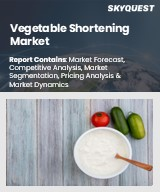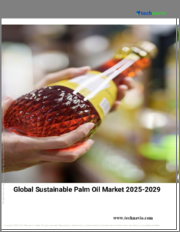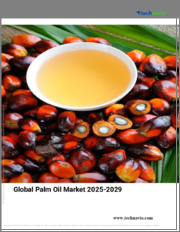
|
시장보고서
상품코드
1800199
세계의 팜유 시장 예측(2025-2030년)Palm Oil Market - Forecasts fom 2025 to 2030 |
||||||
세계의 팜유 시장은 CAGR 3.96%로 확대되어 2025년 587억 1,900만 달러에서 2030년까지 713억 400만 달러로 성장할 것으로 예측됩니다.
팜유는 조유와 정제유의 형태로 이용되고 세계 시장에서 다용도로 사용되는 상품이지만, 원유로서 사용되는 팜유와 팜 핵유는 세계의 1/4에 불과합니다. 팜유는 베이커리 제품, 과자류 및 기타 다양한 식품의 주요 원료로 사용되는 반면, 조유는 동남아시아, 아프리카, 브라질의 일부와 같은 지역에서 가정 요리에 널리 사용됩니다. 주로 아시아, 아프리카, 남미에서 재배되는 팜유는 세계 식용유수요의 대부분을 충족합니다. 그러나 환경 문제, 특히 삼림 벌채에 대한 우려가 예측 기간 동안 시장 성장에 어려움을 겪고 있습니다.
시장 성장 촉진요인
팜유 시장은 인구 증가와 식품 용도의 소비 증가에 자극을 받으며 식용유에 대한 세계수요가 증가함에 따라 견인되고 있습니다. 팜유의 안정성이나 조리에서의 범용성이라고 하는 이점에 관한 건강 의식의 고조가, 그 채용을 뒷받침하고 있습니다. 게다가, 특히 개발도상지역에서 가정용 및 산업용도에서 조유의 사용이 증가하고 있는 것도 주된 성장요인이 되고 있습니다. 베이커리나 과자류 등 식품 가공에 있어서의 비용효과와 기능성이 시장 확대를 더욱 뒷받침하고 있습니다. 열대 지역의 팜유 농장의 확장성은 이수요를 충족하는 시장의 능력을 계속 지원합니다.
시장 성장 억제요인
환경 문제가 팜유 시장 성장의 큰 장벽이 되고 있습니다. 팜유 농원의 확대에 수반하는 삼림 벌채는 환경보호단체나 규제당국의 감시의 눈을 끌어 지속가능한 실천을 요구하는 목소리로 이어지고 있습니다. 이러한 우려가 규제 강화와 소비자의 반발을 초래하여 향후 5년간 시장 확대를 제한할 가능성이 있습니다. 지속 가능한 조달과 인증 프로그램을 통해 이러한 문제를 해결하는 것은 업계 선수들이 시장의 존속성을 유지하는 데 필수적입니다.
목차
제1장 주요 요약
제2장 시장 현황
- 시장 개요
- 시장의 정의
- 조사 범위
- 시장 세분화
제3장 비즈니스 상황
- 시장 성장 촉진요인
- 시장 성장 억제요인
- 시장 기회
- Porter's Five Forces 분석
- 업계 밸류체인 분석
- 정책 및 규정
- 전략적 제안
제4장 기술 전망
제5장 팜유 시장 : 유형별
- 소개
- 조유
- 정제유
- 팜핵유
제6장 팜유 시장 : 업계별
- 소개
- 퍼스널케어 및 화장품
- 바이오에너지 및 전력
- 산업
- 기타
제7장 팜유 시장 : 지역별
- 소개
- 북미
- 유형별
- 업계별
- 국가별
- 미국
- 캐나다
- 멕시코
- 남미
- 유형별
- 업계별
- 국가별
- 브라질
- 아르헨티나
- 기타
- 유럽
- 유형별
- 업계별
- 국가별
- 영국
- 독일
- 프랑스
- 스페인
- 기타
- 중동 및 아프리카
- 유형별
- 업계별
- 국가별
- 사우디아라비아
- 아랍에미리트(UAE)
- 기타
- 아시아태평양
- 유형별
- 업계별
- 국가별
- 중국
- 일본
- 한국
- 인도
- 인도네시아
- 태국
- 기타
제8장 경쟁 환경과 분석
- 주요 기업과 전략 분석
- 시장 점유율 분석
- 합병, 인수, 합의 및 협업
- 경쟁 대시보드
제9장 기업 프로파일
- Carotino Sdn Bhd(JC Chang Group of Companies)
- Yee Lee Corporation Bhd.
- Innovans Palm Industries Sdn Bhd
- Able Perfect Sdn Bhd
- Sarawak Oil Palms Berhad
- Hayel Saeed Anam Group of Companies
- Green Ocean Corporation Berhad
- Muhibah Palm Product Sdn Bhd
- Cargill, Incorporated
- Wilmar International Ltd.
- Sime Darby Plantation Berhad
- IOI Corporation Berhad
- Kuala Lumpur Kepong Berhad(KLK)
제10장 부록
- 통화
- 전제조건
- 기준연도과 예측연도의 타임라인
- 이해 관계자에게 있어서의 주요 이점
- 조사 방법
- 약어
The Palm Oil Market is expected to grow from USD 58.719 billion in 2025 to USD 71.304 billion in 2030, at a CAGR of 3.96%.
Palm oil, utilized in both crude and refined forms, is a versatile commodity in global markets, with only one-quarter of global palm oil and palm kernel oil used as crude oil. It serves as a key ingredient in bakery products, confectioneries, and various other food items, while crude palm oil is widely used for domestic cooking in regions such as Southeast Asia, Africa, and parts of Brazil. Cultivated primarily in Asia, Africa, and South America, palm oil meets a significant portion of the global demand for edible oils. However, environmental concerns, particularly related to deforestation, pose challenges to market growth over the forecast period.
Market Drivers
The palm oil market is driven by the rising global demand for edible oils, spurred by population growth and increasing consumption in food applications. Growing health awareness regarding the benefits of palm oil, such as its stability and versatility in cooking, is boosting its adoption. Additionally, the increasing use of crude palm oil in domestic and industrial applications, particularly in developing regions, is a key growth factor. Its cost-effectiveness and functionality in food processing, including bakery and confectionery products, further propel market expansion. The scalability of palm oil plantations in tropical regions continues to support the market's ability to meet this demand.
Market Restraints
Environmental concerns are a significant barrier to the palm oil market's growth. Deforestation associated with expanding palm oil plantations has drawn scrutiny from environmental groups and regulators, leading to calls for sustainable practices. These concerns may result in stricter regulations and consumer pushback, potentially limiting market expansion over the next five years. Addressing these issues through sustainable sourcing and certification programs will be critical for industry players to maintain market viability.
Market Segmentation
By Application
Palm oil is predominantly used in food applications, including bakery products, confectioneries, and cooking oils. Crude palm oil is particularly valued in domestic cooking in regions like Southeast Asia, Africa, and parts of Brazil due to its affordability and availability. The refined form dominates in processed food industries, where its stability and neutral flavor make it a preferred ingredient. The growing demand for processed foods in emerging economies is expected to drive the food application segment.
By Geography
The palm oil market is concentrated in Asia, Africa, and South America, where tropical climates support large-scale cultivation. Southeast Asia, particularly Indonesia and Malaysia, remains a dominant production hub, driven by extensive plantations and export demand. Africa and South America are also significant contributors, with increasing plantation activity to meet both domestic and global needs. The Asia-Pacific region is expected to maintain its leading market share due to robust production and consumption trends.
Key Industry Players
Major players in the palm oil market include Carotino Group (JC Chang Group), Yee Lee Corporation Bhd., Innovans Palm Industries Sdn Bhd, Able Perfect Sdn Bhd, Sarawak Oil Palms Berhad, Hayel Saeed Anam Group of Companies, Green Ocean Corporation Berhad, Muhibah Palm Product Sdn Bhd, Cargill, Incorporated, and Wilmar International Ltd. These companies are focusing on expanding production capacity and adopting sustainable practices to address environmental concerns.
The palm oil market is poised for growth, driven by increasing demand for edible oils and the versatility of crude and refined palm oil in food applications. However, environmental challenges related to deforestation pose significant risks. Industry players must prioritize sustainability to ensure long-term market stability, particularly in key production regions like Southeast Asia, Africa, and South America.
Key Benefits of this Report:
- Insightful Analysis: Gain detailed market insights covering major as well as emerging geographical regions, focusing on customer segments, government policies and socio-economic factors, consumer preferences, industry verticals, and other sub-segments.
- Competitive Landscape: Understand the strategic maneuvers employed by key players globally to understand possible market penetration with the correct strategy.
- Market Drivers & Future Trends: Explore the dynamic factors and pivotal market trends and how they will shape future market developments.
- Actionable Recommendations: Utilize the insights to exercise strategic decisions to uncover new business streams and revenues in a dynamic environment.
- Caters to a Wide Audience: Beneficial and cost-effective for startups, research institutions, consultants, SMEs, and large enterprises.
What do businesses use our reports for?
Industry and Market Insights, Opportunity Assessment, Product Demand Forecasting, Market Entry Strategy, Geographical Expansion, Capital Investment Decisions, Regulatory Framework & Implications, New Product Development, Competitive Intelligence
Report Coverage:
- Historical data from 2020 to 2024 & forecast data from 2025 to 2030
- Growth Opportunities, Challenges, Supply Chain Outlook, Regulatory Framework, and Trend Analysis
- Competitive Positioning, Strategies, and Market Share Analysis
- Revenue Growth and Forecast Assessment of segments and regions including countries
- Company Profiling (Strategies, Products, Financial Information, and Key Developments among others.
Palm Oil Market Segmentation
The palm oil market has been analyzed through the following segments:
By Type
- Crude Oil
- Refined
- Palm Kernel Oil
By Industry Verticals
- Food and Beverage
- Personal Care and Cosmetics
- Bionergy and Power
- Ibndustrial Uses
- Others
By Geography
- North America
- USA
- Canada
- Mexico
- South America
- Brazil
- Argentina
- Others
- Europe
- United Kingdom
- Germany
- France
- Spain
- Others
- Middle East and Africa
- Saudi Arabia
- UAE
- Others
- Asia Pacific
- China
- Japan
- South Korea
- India
- Indonesia
- Thailand
- Others
TABLE OF CONTENTS
1. EXECUTIVE SUMMARY
2. MARKET SNAPSHOT
- 2.1. Market Overview
- 2.2. Market Definition
- 2.3. Scope of the Study
- 2.4. Market Segmentation
3. BUSINESS LANDSCAPE
- 3.1. Market Drivers
- 3.2. Market Restraints
- 3.3. Market Opportunities
- 3.4. Porter's Five Forces Analysis
- 3.5. Industry Value Chain Analysis
- 3.6. Policies and Regulations
- 3.7. Strategic Recommendations
4. TECHNOLOGICAL OUTLOOK
5. PALM OIL MARKET BY TYPE
- 5.1. Introduction
- 5.2. Crude Palm Oil
- 5.3. Refined
- 5.4. Palm Kernel Oil
6. PALM OIL MARKET BY INDUSTRY VERTICAL
- 6.1. Introduction
- 6.2. Personal Care and Cosmetics
- 6.3. Bioenergy and Power
- 6.4. Industrial Uses
- 6.5. Others
7. PALM OIL MARKET BY GEOGRAPHY
- 7.1. Introduction
- 7.2. North America
- 7.2.1. By Type
- 7.2.2. By Industry Vertical
- 7.2.3. By Country
- 7.2.3.1. USA
- 7.2.3.2. Canada
- 7.2.3.3. Mexico
- 7.3. South America
- 7.3.1. By Type
- 7.3.2. By Industry Vertical
- 7.3.3. By Country
- 7.3.3.1. Brazil
- 7.3.3.2. Argentina
- 7.3.3.3. Others
- 7.4. Europe
- 7.4.1. By Type
- 7.4.2. By Industry Vertical
- 7.4.3. By Country
- 7.4.3.1. United Kingdom
- 7.4.3.2. Germany
- 7.4.3.3. France
- 7.4.3.4. Spain
- 7.4.3.5. Others
- 7.5. Middle East and Africa
- 7.5.1. By Type
- 7.5.2. By Industry Vertical
- 7.5.3. By Country
- 7.5.3.1. Saudi Arabia
- 7.5.3.2. UAE
- 7.5.3.3. Others
- 7.6. Asia Pacific
- 7.6.1. By Type
- 7.6.2. By Industry Vertical
- 7.6.3. By Country
- 7.6.3.1. China
- 7.6.3.2. Japan
- 7.6.3.3. South Korea
- 7.6.3.4. India
- 7.6.3.5. Indonesia
- 7.6.3.6. Thailand
- 7.6.3.7. Others
8. COMPETITIVE ENVIRONMENT AND ANALYSIS
- 8.1. Major Players and Strategy Analysis
- 8.2. Market Share Analysis
- 8.3. Mergers, Acquisitions, Agreements, and Collaborations
- 8.4. Competitive Dashboard
9. COMPANY PROFILES
- 9.1. Carotino Sdn Bhd (JC Chang Group of Companies)
- 9.2. Yee Lee Corporation Bhd.
- 9.3. Innovans Palm Industries Sdn Bhd
- 9.4. Able Perfect Sdn Bhd
- 9.5. Sarawak Oil Palms Berhad
- 9.6. Hayel Saeed Anam Group of Companies
- 9.7. Green Ocean Corporation Berhad
- 9.8. Muhibah Palm Product Sdn Bhd
- 9.9. Cargill, Incorporated
- 9.10. Wilmar International Ltd.
- 9.11. Sime Darby Plantation Berhad
- 9.12. IOI Corporation Berhad
- 9.13. Kuala Lumpur Kepong Berhad (KLK)
10. APPENDIX
- 10.1. Currency
- 10.2. Assumptions
- 10.3. Base and Forecast Years Timeline
- 10.4. Key Benefits for the Stakeholders
- 10.5. Research Methodology
- 10.6. Abbreviations



















